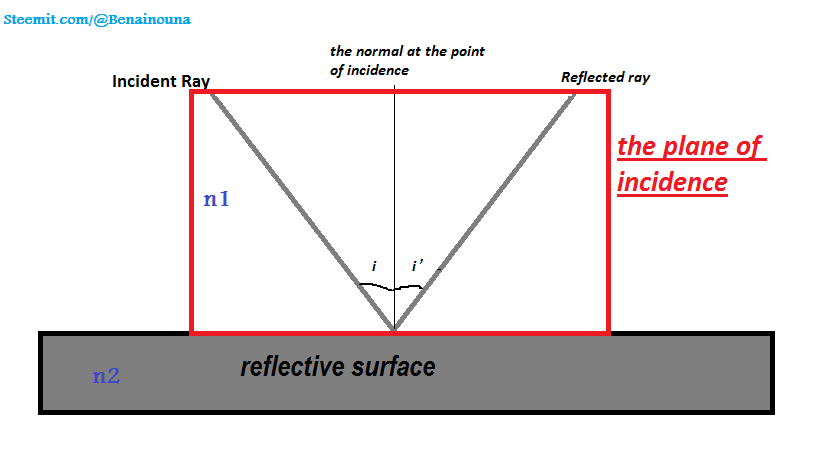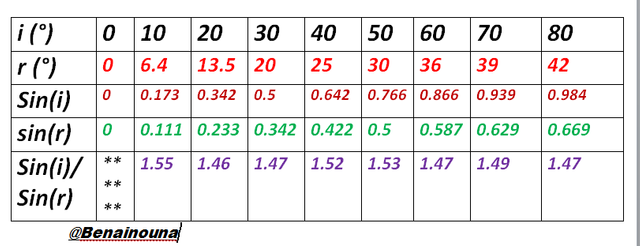All about optics [Part 3: Reflection and refraction]
Previous parts "all about optics":
All about optics [Part 1: introduction]
All about optics [Part 2: light and geometrical optics]
Passage of light from one medium to another:
Light spreads in different mediums and each medium has its own properties, where some phenomena appear with the passage of light from one medium to another, which means different propagation properties:
- The blackout materials does not allow light to pass, so it stops the spread of light rays.
- When a part of the light continues to propagate in the second medium it is a phenomenon of refraction.
- The light can be returned in the opposite direction at the interface between two different mediums, that’s a phenomenon of Reflection.

[Self made figure n:1]
Some terms in geometrical optics:
- Diopter:
It is the surface that separates between two different homogeneous mediums. - Mirror:
It is a glass element, with a metallic deposit (for example: silver or aluminum), this element (mirror) has a reflective surface. - Normal:
In optics the normal is the line perpendicular to the reflective or refracting surface. - Incident Ray:
It is the ray of a light coming from a certain direction and pointing towards a reflective or refracting surface. - Reflected ray:
It is the ray reflected by a reflective surface, because of incidence of a ray of light towards this surface. - Plane of incidence:
It is the plane perpendicular to the surface (second medium: diopter or mirror), this plane is containing the incident ray, the reflected ray, and the normal. - Angle of incidence (i):
(i) It is the angle between the incident ray and the normal.
Laws of reflection:
On a reflecting surface, an incident light ray is totally or partially reflected backwards in a given direction or in all directions, this phenomenon is called reflection, it is easy for us to understand reflection because it is present in our lives every time we see ourselves in the mirror as the radiation falling on the mirror reflected directly towards the eye and so we see our image.
The first law of reflection:
The incident ray and the reflected ray (which is the symmetry of the incident ray with respect to the normal) define a plane perpendicular to the reflecting surface, called the plane of incidence.

[Self made figure n:4]The second law of reflection:
The angle of incidence (i) is equal to the reflective angle (i '): i = i'.
[Self made figure n:5]
Laws of refraction:
What if we put a fidget spinner in the bottom of a bowl over a table, if we move a certain distance we will notice that it is impossible to see this object.

[Self made figure n:6]
Well, you can stay in the same location, and ask someone to pour water into the bowl until it is full.

[Self made figure n:7]
You can now see the spinner or part of it from the same angle and from the same distance that you could not see them before adding water. What's the reason?
The bowl does not allow light from the spinner to pass through it to the eye, but after filling the bowl with water, the light rays from the spinner deviate because it is passing from a medium to another.
- But what do we really see is the real object?
What the eye sees in this case is not the real spinner, but his imagination:
[Self made figure n:8]
When the light moves from a transparent and homogeneous medium to another different transparent and homogeneous medium, deviates from its primary orientation, this phenomenon is called: refraction of light
- (SI) is called: incident ray.
- (IR) is called: refracted ray.
- (i) is called: angle of incidence.
- (r) is called: angle of refraction.
Experimental study of refraction:
Using a light source, Hartl optical disc, we rotate the disc, and determine the refractive angle of different incident angles:
[Self made figure n10]
We note that the Sin(i)/Sin(r) appears constant regardless of the angle of incidence, and from it we conclude that Sin(i) is directly proportional to Sin(r).
Sin(i)= a Sin(r)......... So: Sin(i)/Sin(r)= a
If we do the same experiment by changing the glass in the center of the disc, we will get the same results but the value of "a*" will only change, and from it we conclude that "a" is a constant distinguishing the transparent medium.
Snell's laws:
First law of refraction:
The plane of incidence, which is perpendicular to the separation surface of two media, contains: the incident ray, the refracted ray, and the normal.
Second law of refraction:
Sin(i)/Sin(r) for two transparent mediums is constant regardless of the angle of incidence.
Sin(i)/Sin(r)= n.
- The constant "n" is called: index of refraction.
- The refractive index of the passage of light from one medium to another is the refraction index of the second medium "n2", dividing the refraction index of the first medium "n2" (example: passage of light from air into water)
From which the following law can be inferred:
n1 Sin(i)= n2 Sin(r)
- If n2 is smaller than n1, the refracted ray deviates from the normal.
- If n2 is greater than n1, the refracted ray is closer to the normal.
Refractive index for some materials:
Vacuum: n=1
Acetone (gaz): n= 1.001090
Acetone (liquid): n= 1.36
Air: n= 1.000293
Carbon dioxide: n= 1.000449
Carbon monoxide: n= 1.000338
Helium: n= 1.000035
Milk: n= 1.35
Oil, cedar: n= 1.516
Water: n= 1.333
Hydrogen: n=1.000132
Methane: n=1.000444
Nitric oxide: n=1.000297
Nitrogen: n=1.000298
Nitrous oxide: n=1.000516
Oxygen: n=1.000271
Pentane: n=1.000686
Sulphur dioxide: n=1.000686
Salt: n=1.52
Ice: n=1.31
Diamond: n=2.417
References:
- Optique géométrique, Richard Taillet, chapter n2: Reflection and refraction
- Physique generale, Nour Eddine Hakiki, publications universitaires, chapter 18: Optique geometrique, page147
Cours d'optique général, Martin P. Lévesque RDDC – Centre de recherches de Valcartier
Dear steemians:
thank you for reading.
- If you like this post upvote and follow To be informed of upcoming posts.
- If there is any comment, criticism or additional information, please write it down.
@Benainouna

Good job!
I don't know as much as I want about optics but I think that you covered it nicely. It reminds me of when I was a student and was superficial about some of the classes, which I thought they wouldn't help me a lot.
Big mistake there for me!
It's clearly a good article and you are on a good path here.
I really like that you have made your own figures and photos.
Thank you so much mr @Alexdory and it's never too late to learn optics lol, Your advice helped me a lot and I do not know how to thank you :) Thank you very much
It was my pleasure, relax!
There's no need for "Mr" :D , I was always the youngest in the team, it has changed a little these couple of years but I'm still no Mr
Lol :p Thank you for your modesty :)
You have dead links
wich ones?
The two under references for sure, I am on my phone so I haven't checked them all
@kryzsec Thanks for your note, I've changed the way I type it :)
This is a printed book with no link
@benainouna has made great progress and also more work in the last few articles, formatting and content wise.
As a mentor, I will continue to give my advice, and the sources crediting will improve :P